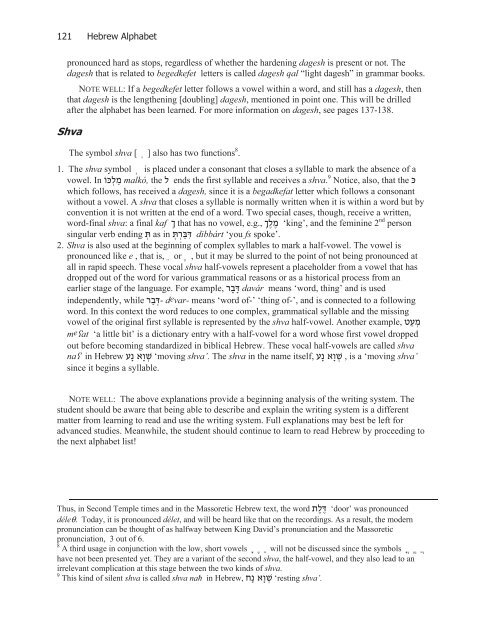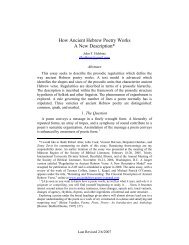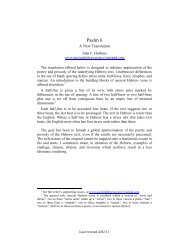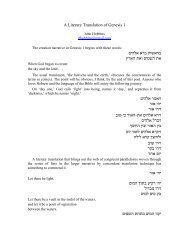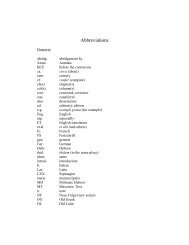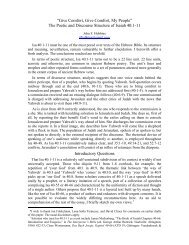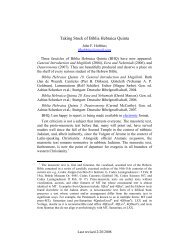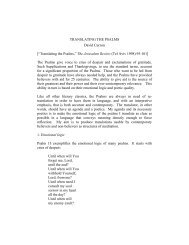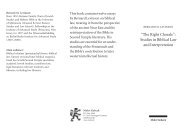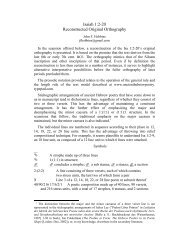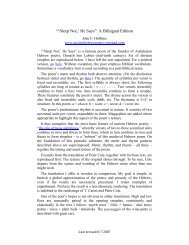Living Biblical Hebrew - Ancient Hebrew Poetry
Living Biblical Hebrew - Ancient Hebrew Poetry
Living Biblical Hebrew - Ancient Hebrew Poetry
You also want an ePaper? Increase the reach of your titles
YUMPU automatically turns print PDFs into web optimized ePapers that Google loves.
121<strong>Hebrew</strong> Alphabetpronounced hard as stops, regardless of whether the hardening dagesh is present or not. Thedagesh that is related to begedkefet letters is called dagesh qal “light dagesh” in grammar books.NOTE WELL: If a begedkefet letter follows a vowel within a word, and still has a dagesh, thenthat dagesh is the lengthening [doubling] dagesh, mentioned in point one. This will be drilledafter the alphabet has been learned. For more information on dagesh, see pages 137-138.ShvaThe symbol shva [ ] also has two functions 8 .1. The shva symbol is placed under a consonant that closes a syllable to mark the absence of avowel. In malkó, the ends the first syllable and receives a shva. 9 Notice, also, that the which follows, has received a dagesh, since it is a begadkefat letter which follows a consonantwithout a vowel. A shva that closes a syllable is normally written when it is within a word but byconvention it is not written at the end of a word. Two special cases, though, receive a written,word-final shva: a final kaf that has no vowel, e.g., ‘king’, and the feminine 2 nd personsingular verb ending as in dibbárt ‘you fs spoke’.2. Shva is also used at the beginning of complex syllables to mark a half-vowel. The vowel ispronounced like e , that is, or , but it may be slurred to the point of not being pronounced atall in rapid speech. These vocal shva half-vowels represent a placeholder from a vowel that hasdropped out of the word for various grammatical reasons or as a historical process from anearlier stage of the language. For example, davár means ‘word, thing’ and is usedindependently, while - devar- means ‘word of-’ ‘thing of-’, and is connected to a followingword. In this context the word reduces to one complex, grammatical syllable and the missingvowel of the original first syllable is represented by the shva half-vowel. Another example, meat ‘a little bit’ is a dictionary entry with a half-vowel for a word whose first vowel droppedout before becoming standardized in biblical <strong>Hebrew</strong>. These vocal half-vowels are called shvana in <strong>Hebrew</strong> ‘moving shva’. The shva in the name itself, , is a ‘moving shva’since it begins a syllable.NOTE WELL: The above explanations provide a beginning analysis of the writing system. Thestudent should be aware that being able to describe and explain the writing system is a differentmatter from learning to read and use the writing system. Full explanations may best be left foradvanced studies. Meanwhile, the student should continue to learn to read <strong>Hebrew</strong> by proceeding tothe next alphabet list!Thus, in Second Temple times and in the Massoretic <strong>Hebrew</strong> text, the word ‘door’ was pronounceddéleθ. Today, it is pronounced délet, and will be heard like that on the recordings. As a result, the modernpronunciation can be thought of as halfway between King David’s pronunciation and the Massoreticpronunciation, 3 out of 6.8 A third usage in conjunction with the low, short vowels will not be discussed since the symbols have not been presented yet. They are a variant of the second shva, the half-vowel, and they also lead to anirrelevant complication at this stage between the two kinds of shva.9 This kind of silent shva is called shva na in <strong>Hebrew</strong>, ‘resting shva’.


